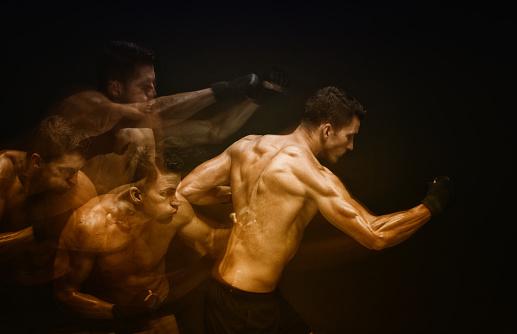unlock the next domain of human performance
the science behind myelin
Current methods of teaching and training in boxing are complex and ambiguous. Most coaches complete the process of systematic teaching after novice athletes first get acquainted with a set of basic techniques used in boxing exercises.
Systematic teaching only continues through the initial stages of training. The rest of the time is not devoted to training technique or developing tactical knowledge.
The learning and development process is largely unstructured and performed close to free or conditional fighting. On one hand, such an approach sufficiently restricts the technical and tactical arsenal of boxers and on the other, makes boxing less aesthetic.
In the absence of a planned and systematic process of training, boxing can turn into a set of chaotic techniques, the implementation of which would be based mainly on the natural abilities of the athlete and would not be the product of the system or the coach’s creativity.
Many talented young boxers leave the sport without achieving the best of their ability because of the lack of structured and achievable process goals the like you would
see in other martial arts.
In the process of a long-term codified training system, the athlete, teacher and trainer are fundamentally interconnected and regarded as intertwined components of a single educational process.
our approach
Our approach combines biomechanics, neuroscience, and performance tracking to help athletes reach their highest potential.

Led by experts in human performance, the Myelin Chi team brings together deep knowledge in science, sport and cognitive training.

MYELIN CHI COMBINES PRACTICAL AND SCIENTIFIC ELEMENTS THROUGH ITS CODIFIED SYSTEM TO UNLOCK THE NEXT DOMAIN OF HUMAN PERFORMANCE.

PILLAR 1 – PRACTICAL APPLICATION – GYM FOCUSED
The end aim of practical, gym focused training is achieving high results via the improvement of motor skills, and the development of determination and cognitive
qualities.

Elements
Pads. Heavy bag. Working with a partner. Footwork patterns. Combinations. Switch stances. Shadow boxing in the mirror.
Approach
Focusing. Obsessing over the accurate repetitive reproduction of techniques and skills.
The more we can activate the same sequence of neurons together, the more we start to harness the power of neuroplasticity.
The architecture that supports the technique becomes optimised. Myelin starts to form thus dramatically speeding-up neural impulses.

“Neurons that fire together wire together”
MOTOR ABILITY
This is a consciously performed action, requiring great attention and control. It is characterised by the instability of the performing.

MOTOR SKILL
An arbitrary action, the performance of which, as well as control, is carried out automatically, and the action itself is reliable and stable.
SYSTEMATIC REPETITIVE SKILLS TRAINING NEUROPLASTICITY
Neuroplasticity “Neurons that fire together wire together” the initial construction of dedicated skills based synaptic architecture.
PILLAR 2 – THEORETICAL FOUNDATIONS – CLASSROOM SETTING
During the classroom setting, boxers form tactical knowledge, strategic and technical thinking, visual imagery, logical imagery.

Valentine Ostyanov
The focus of teaching is to form knowledge, abilities and skills, whereas in training, the end aim is achieving high results via the improvements of motor skills, and the development of determination and cognitive qualities. The formation and
improvement of motor abilities and skills are important in the management of motor actions.
PILLAR 3 – THEORY OF FUNCTIONAL SYSTEMS

A functional system arises when a set of stimulated senses (afferent synthesis)
appears in the higher neocortex of the large hemispheres of the brain, which serves
as a prerequisite for the decision to take action. So, each motor action has it
beginning in the amalgamation of stimulated senses in the higher neocortex. The
afferent synthesis happens on the basis of the dominant motivation, caused by
different stimulating action from outside. The motivating stimuli cause the active
analysis and estimation of the expected action.

The basis of motor skill, according to Pavlov, is the formation of a dynamic stereotype (stable pattern) of the process of the nervous system in the higher neocortex. In other words, the dynamic stereotype is a stable state of the functional system, consolidated as a result of repeated actions.
Any movement learnt has it beginning in the creation of the conditioned reflex connections in the cerebral cortex. Signals travelling from the central nervous system (CNS) to the functional organs switch on corresponding muscle groups to perform the movement. Movement correction results from the external (sensory organs) and internal (proprioceptors) control circuits, which transmit information to the central nervous system about the progress of the movement.
The dynamic stereotype determines all of the main features of a motor skill: the
automated movement management, solidity of movements, and reliability of the
actions. Well mastered, automated, and stably performed technique is in essence –
motor skill. These skills are positively transferable, so Myelin develops athletes who can comfortably switch stances whilst retaining quality.
However, being a relatively inert functional formation, it cannot always correspond to changing conditions, change, if necessary of a stable cortical dynamic stereotype, as a rule requires a lot of time and energy, and will take years of retraining. It is easier to teach correctly than to re-educate.
PILLAR 4 – Flow: Emotional & Attentional Intelligence
Emotional & Attentional intelligence in-part gives us the ability to be aware of and control our Flow State. This is critical within a sport like boxing which combines technical and physical aspects that require control at a conscious and un-conscious level.
The importance of emotional intelligence is underestimated in sport and the Myelin Method seeks to address this by establishing a pillar that runs throughout all aspects of training. When you consider that all sensory stimuli are processed via a stereotypical pathway: Sensory stimulus enters through the reptilian brain, then through the mammalian brain also known as the limbic system and then through to the human cortex, essentially, we are a feeling species that thinks and without the ability to control our emotions and attention the higher reaches of the brain are problematic to access.
We blend concepts like MBCT, MSPE, REBT and stream entering from Buddhism with modern neuroscience to help our athletes limit the activation of emotional cellular groups such as the lateral and central nucleus of the amygdala and control Parasympathetic and Sympathetic nervous states thus regulating stress hormones like cortisol and adrenalin.
By harnessing the power of neuroplasticity, we can train athletes to enter a Flow state on demand, this pathway consist of five constituent components: Concentration, Letting go, Relaxation, Harmony and Rhythm and forming key associations, combine this with attention regulation and emotion regulation we enter FLOW.
